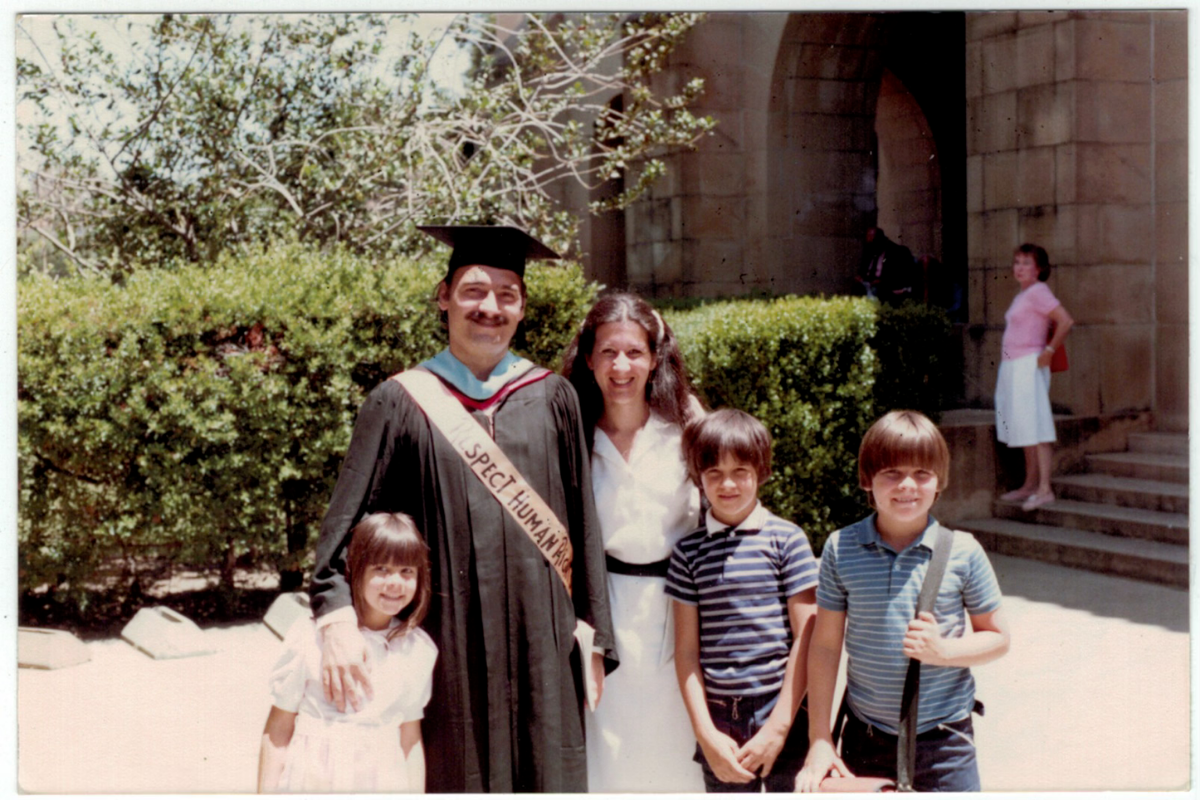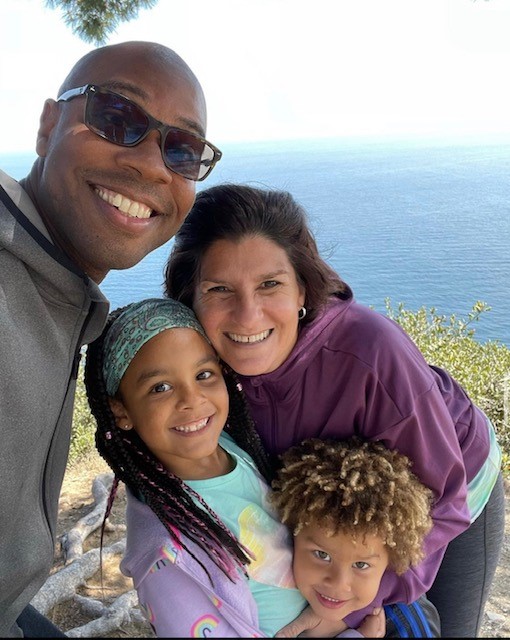Lost in Transitions: How Laura McMullin Found Her Way Home

Laura McMullin still remembers the feeling of alienation she experienced as an immigrant student.
It was her first day at a new school. While sitting in class, her eyes scanned an expectant crowd as her classmates, although well intentioned, congregated around her, speaking slowly but loudly as if she was a strange creature being observed at a zoo.
“I went from living in a Spanish-speaking world to being transplanted into a bilingual French-Canadian-English world,” Laura said. “It was like taking a palm tree and planting it in Alaska.”
Wrestling with abstract notions of identity and place was nothing new to Laura. She was born in Argentina, but at two months old, her family settled in Mexico City to escape military-sponsored state terrorism. Then, at nine years old, moved to Edmonton Canada and at the age of 14 moved to the United States. “I used to feel like I didn’t belong anywhere, you know, neither here nor there,” Laura said.
Growing up cross culturally in four countries on two continents was challenging at times, but it was the comfort of family along with kindness of supportive friends and teachers that anchored her time and time again, and unbeknownst to her, served as a blueprint to the teacher she would one day become.
Laura arrived in California in the early 90s. By now, she had learned to embrace the different cultural dimensions of her personality. As an undergraduate at UC Berkeley, she majored in sociology where she studied how structural inequality is generated in terms of race, class, sex, and gender. She was always sensitive to human suffering as a child, and the more her awareness grew, the more committed she became to social justice.
To wrap her final semester up, Laura tutored a 10th grade history class where she met a student who had dreams of attending UC Berkeley and spoke of his aspirations with passion and intellect, but his reading and writing capabilities were at a 3rd grade level.
“It didn’t make sense to me,” Laura expressed. “He was a bright kid with dreams to go to college, so what happened between 3rd and 10th grade? Why didn’t the system prepare him to fulfill his dream? All I could think about was how the system failed him, and I knew it wasn’t just him.”
This realization propelled her into a career in education. After graduating from UC Berkeley with a degree in sociology, Laura got a master’s degree in social justice education from UCLA. Soon after, she started teaching at an elementary school in Lennox, California, beginning with 3rd grade.
As a teacher at a dual language school, Laura taught from a place of love and encouragement. To her, each student was exceptional. She called the best out of them and they rose every time. Teaching was more than a profession – it was a calling rooted in a commitment to social justice and transformative student-teacher relationships.
“I knew I was there to plants seeds of possibility,” Laura said. “Everything we did academically was connected to a bigger purpose to help those seeds grow. I wanted them to be able to maneuver through the world with full confidence in their abilities and navigate the system successfully.”
Early in her teaching career, Laura was fueled by days of passionate engagement in purposeful work. So much so that she was featured in Teaching to Change the World, a book by pioneering scholar Jeannie Oakes that serves as an introduction to social justice education. However, like many purpose-driven educators, she struggled with balancing her work life and personal life.
Aside from her students, Laura didn’t have much of a social life and her closest friends lived far away. To find balance, she moved to New York City, where one of her best friends lived, and settled in Spanish Harlem, a neighborhood with a predominantly Spanish-speaking population, eager and ready to replicate her pedagogy at a new school.
What she didn’t expect, though, was the unforeseen struggle of adapting to a school environment that had a large population of children with adverse childhood experiences and little support for the teachers to learn how to respond to their needs.
“There was a lot of trauma manifesting in the classroom, and I hadn’t been trained on how to respond to it nor how to fortify myself,” Laura recalled. “My strategy for dealing with stress was to work harder, to work longer, and to do more. It never occurred to me that taking care of myself was an essential part of the equation in order to be able to meet the needs of my students.”
Instead, Laura kept giving and giving without ever replenishing her own energy until burning out in a profession that lit her up. “The burnout cascade was like being in quicksand,” Laura said. “I sank with nothing to grab onto.”
Day by day Laura felt a growing emptiness inside that became too obvious to ignore. She knew she could no longer be in the classroom given the state of depletion she was in. This realization was painful and extremely disorienting considering she thought she would be teaching for the next 30 years.
“I remember walking down the street in New York City feeling hollow, empty, and gray inside. All the passion, the spark, the joy – my essence – was gone. It felt like my soul had evacuated my body. That’s how painful it was,” Laura said. “I didn’t recognize myself anymore. I found myself just going through the motions wondering, where did I go?”
For the following years, Laura focused on recovery. To aid her healing process, she integrated wellbeing practices, like meditation, journaling, being in nature, personal development, and contemplation. Having stepped out of the classroom, Laura was presented with the option of entering a PhD program in education at NYU with her long-time mentor, Pedro Noguera, who she had met at Berkeley decades earlier.
With a full scholarship to go back to school, Laura ended up studying teacher stress and burnout to make sense of what happened to her. It was during this time Laura discovered the robust scientific research on mindfulness. Fascinated by the scientific study of a contemplative practice, she focused her dissertation on mindfulness and social emotional wellbeing for teachers.

Bumping into mindfulness brought back hope, Laura said, because it taught her how to stay grounded in stressful situations. In 2011, she moved back to California and became a faculty advisor in UCLA’s Teacher Education Program – the same program she graduated from 20 years earlier – and integrated mindfulness, self-compassion, and social emotional wellbeing into her work with teachers.
One day, during Laura’s regular field visits in support of her students, she visited a student teacher who was placed at an elementary school in Watts. Laura watched in amazement as students practiced breathing and counting relaxation exercises — mind-body techniques introduced to them through a Calm Classroom program, a program provided to the schools by the UCLA Center for Anxiety Resilience Education and Support (CARES).
Floored with excitement, Laura went online and searched “Calm Classroom,” which connected her to Kate Sheehan, the managing director of UCLA CARES. Soon after, Laura invited Kate to her advisory class to talk to teachers about burnout and to share her knowledge on supporting students who may be experiencing anxiety in the classroom. Kate and Laura worked together to facilitate a number of workshops of teachers after that, including one on mindful self-compassion.
“Kate was a bridge who connected me to Lauren Marlotte, and the three of us met to discuss ways we could potentially support teacher resilience, inspired by the Families OverComing Under Stress program,” Laura said. “I was so inspired by these women who were doing what I dreamed of doing.”
Fortunately, there was an opening in the newly forming DMH + UCLA Prevention Center of Excellence, and Laura was the perfect fit.
At the time, the Prevention Center of Excellence was in its early stages. The team was small. There was no system, no infrastructure, and Laura became part of the initial building process. Her first duty? Help create the curriculum for the first trauma and resilience informed training.
“I remember we were working on the Trauma and Resilience Informed Care Foundations training, and I don’t know what happened, but I felt like my voice, my ideas, and my leadership just came out of me,” Laura shared. “I experienced myself in ways I hadn’t before – like my leadership and voice was finally ignited, and for that I’m grateful for the center, because it helped me get to that next level.”
Since then, Laura has facilitated numerous trainings on mindfulness, social-emotional wellbeing, and resilience building to educators from a social justice framework. Much of her work as a trainer and curriculum developer focuses on providing concrete strategies to stay grounded and centered; an art Laura mastered while finding her way home.
“Over time I realized that when it comes to a sense of belonging, at least for me, it isn’t about location or identity, it’s about belonging to who I am internally,” Laura expressed. “Home is in here – my heart – within me, and when I’m connected to my heart, my inner core self, I know I belong.”
Today, Laura remains committed to helping educators integrate who they are with the work they are called to do by guiding them on their journey of cultivating wholeness and dynamic wellbeing.
Visit the Wellbeing for LA Learning Center to explore evidence-based trainings from the UCLA Prevention Center of Excellence team!